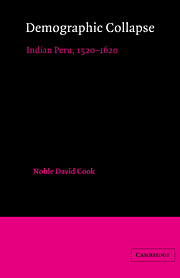Book contents
- Frontmatter
- Contents
- List of tables, figures, and maps
- Preface
- Introduction: The problem in perspective
- Part I Peru's preconquest population
- 1 The ecological approach
- 2 Population and archaeology
- 3 Depopulation ratios
- 4 Estimates from social organization
- 5 Disease mortality models
- 6 Census projections
- 7 Conclusion
- Part II Demographic collapse
- Abbreviations used in notes
- Notes
- Bibliography
- Index
- Titles in the series
6 - Census projections
Published online by Cambridge University Press: 02 December 2009
- Frontmatter
- Contents
- List of tables, figures, and maps
- Preface
- Introduction: The problem in perspective
- Part I Peru's preconquest population
- 1 The ecological approach
- 2 Population and archaeology
- 3 Depopulation ratios
- 4 Estimates from social organization
- 5 Disease mortality models
- 6 Census projections
- 7 Conclusion
- Part II Demographic collapse
- Abbreviations used in notes
- Notes
- Bibliography
- Index
- Titles in the series
Summary
Of course, statistical analysis is possible only if there is a great number of variables. The more causes that combine to generate an effect, the more dependable that effect will be. In particular, extrapolation assumes that the trend observed over a period can be depended upon not to change too much shortly before and after that period; the more the causes responsible for the trend, the more reliable this assumption will be.
R. A. Zambardino, “Critique of David Henige's ‘On the Contact Population of Hispaniola,’’ p. 706Demographers have for a long period of time estimated populations for dates on which no census was taken. Even if national censuses were available for 1920, 1930, and 1940, for the purpose of analysis it might be important to know the total population at intervening dates. If accurate and complete vital registration were available, estimating the total population at a point in time would be a simple process of addition and subtraction; but an adequate system of vital registration is rare, even in the twentieth century, especially in underdeveloped portions of the globe. Therefore, for the purpose of estimating population in the past or future the standard formula for population change becomes a necessary analytical tool. The formula P2 = P1ert represents change as a continuous process, which is indeed true of population movement. The curve of population growth, positive or negative, is an exponential curve, not a straight line. The process reflected by the formula is the same as that for the continuous compounding of interest.
- Type
- Chapter
- Information
- Demographic CollapseIndian Peru, 1520–1620, pp. 75 - 107Publisher: Cambridge University PressPrint publication year: 1982



